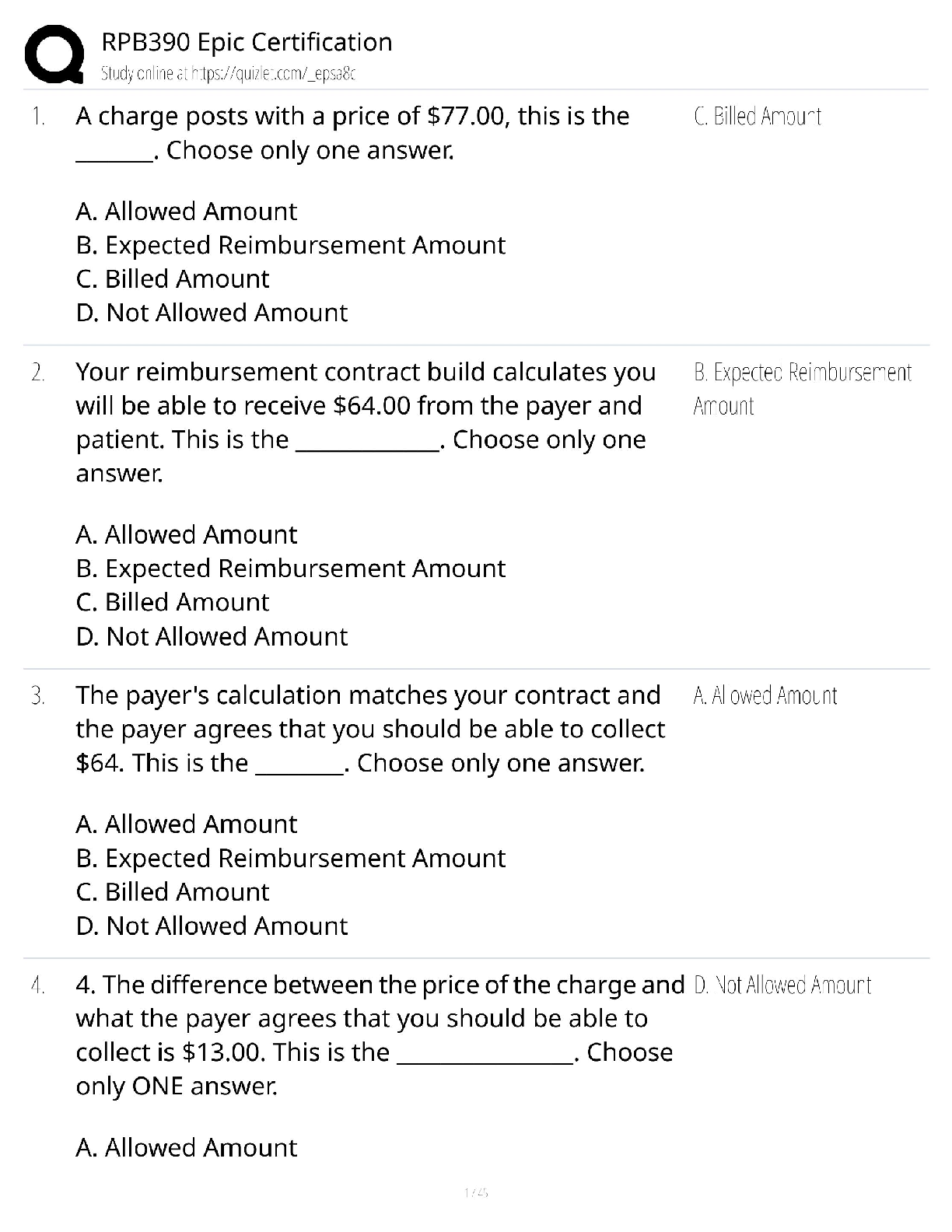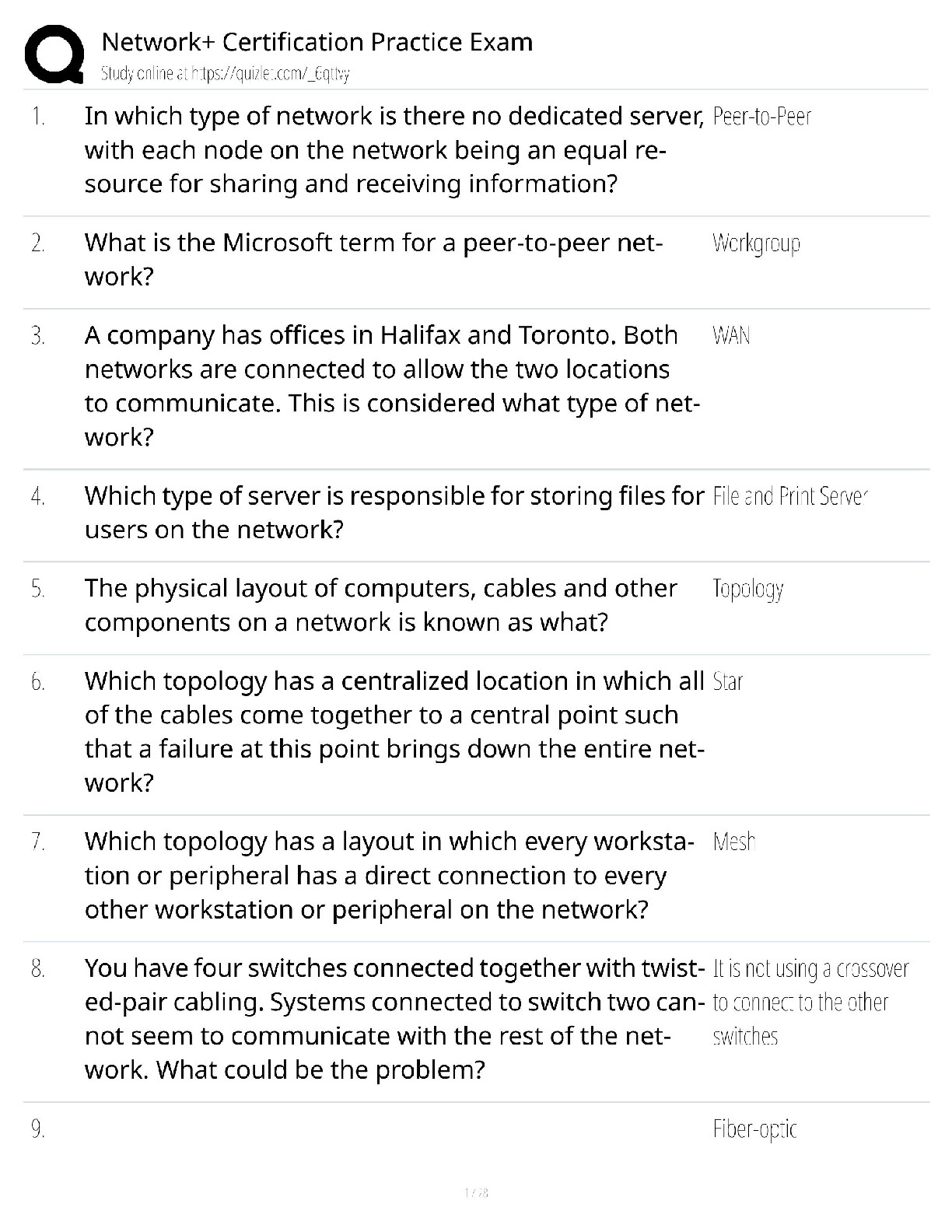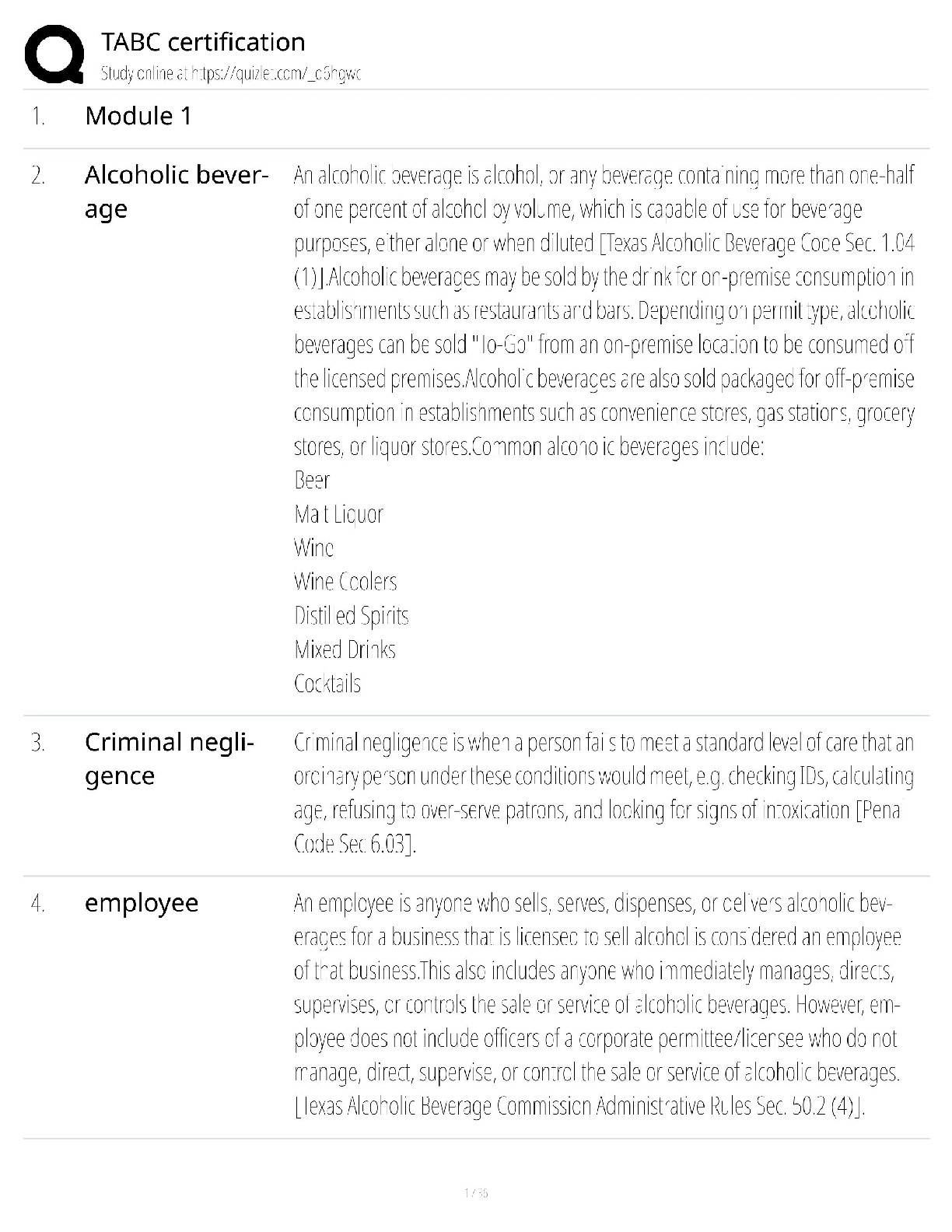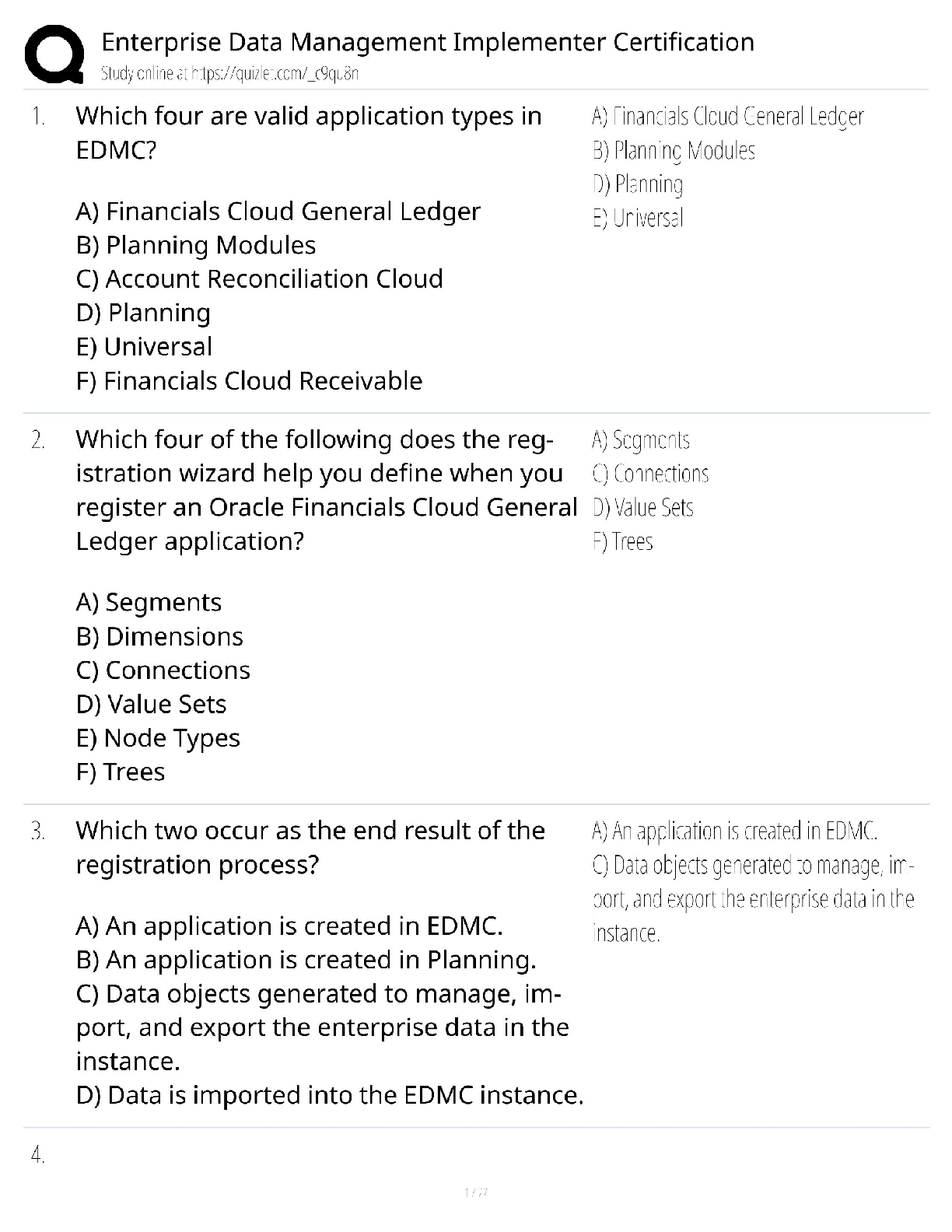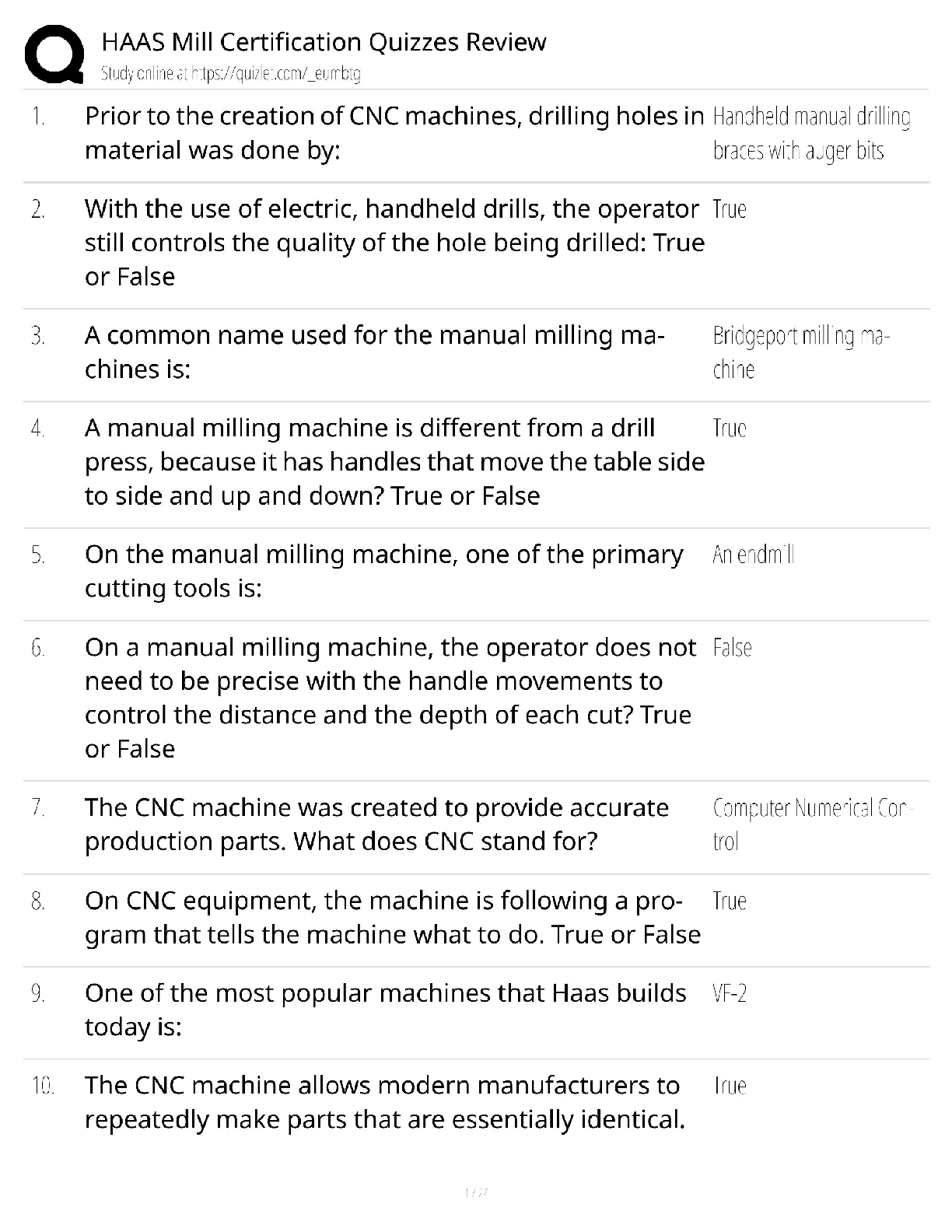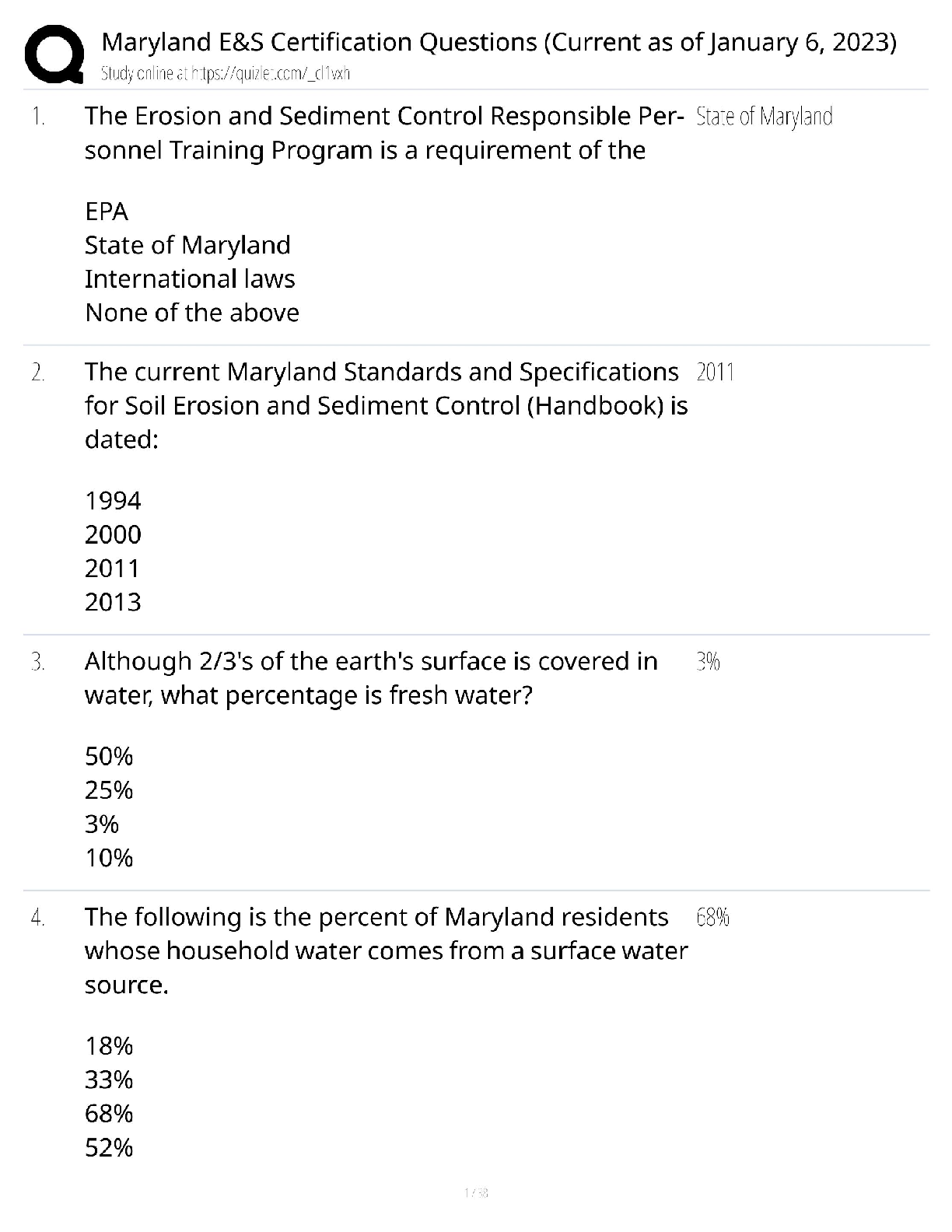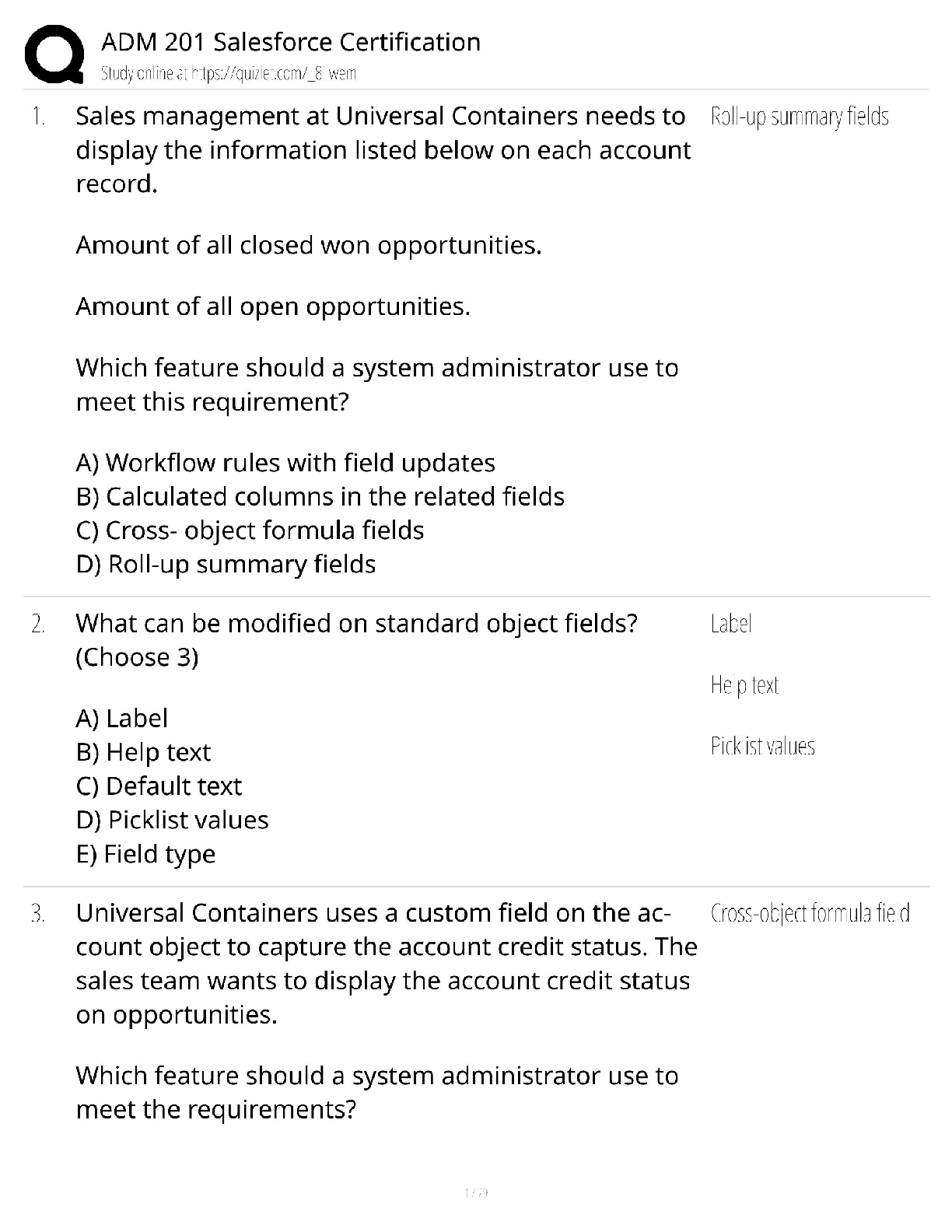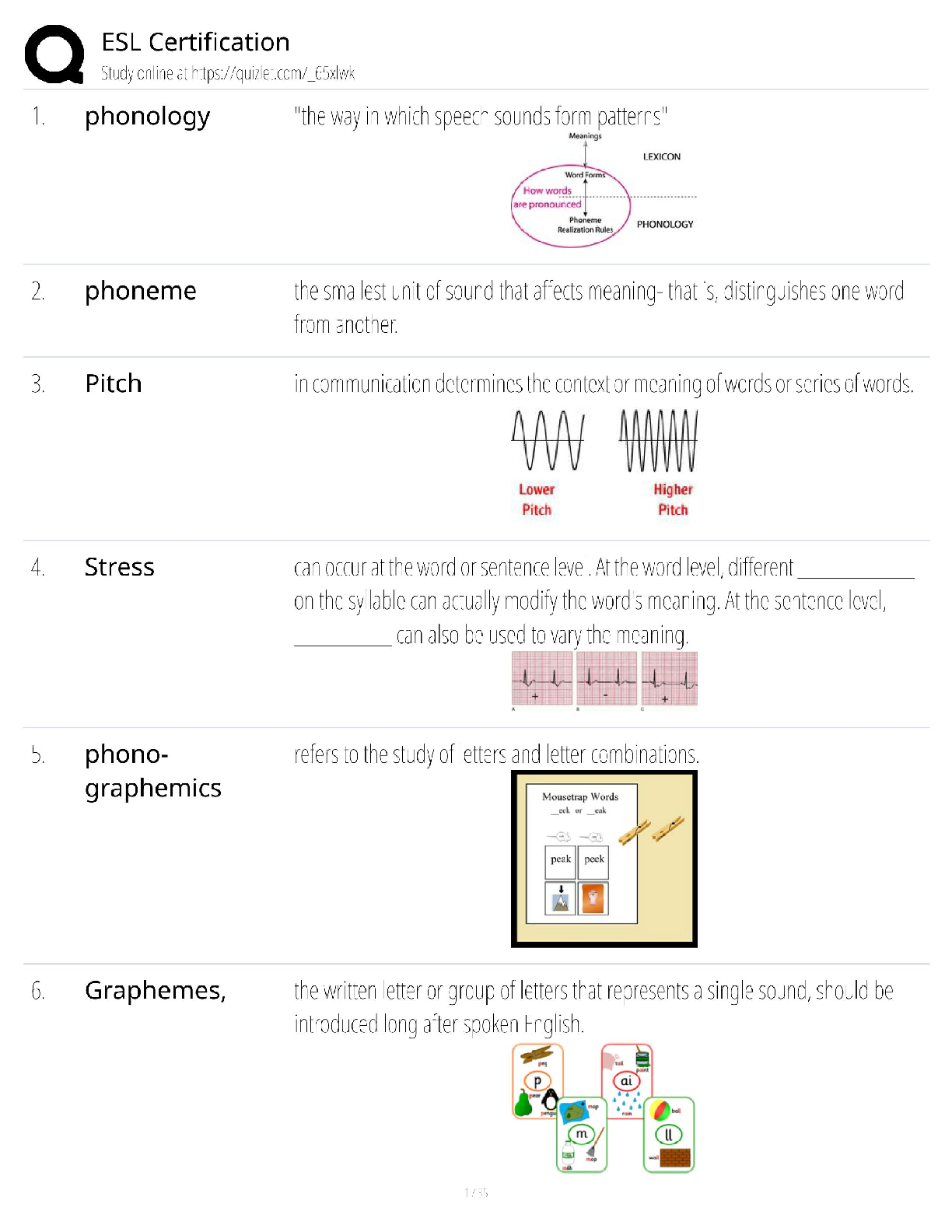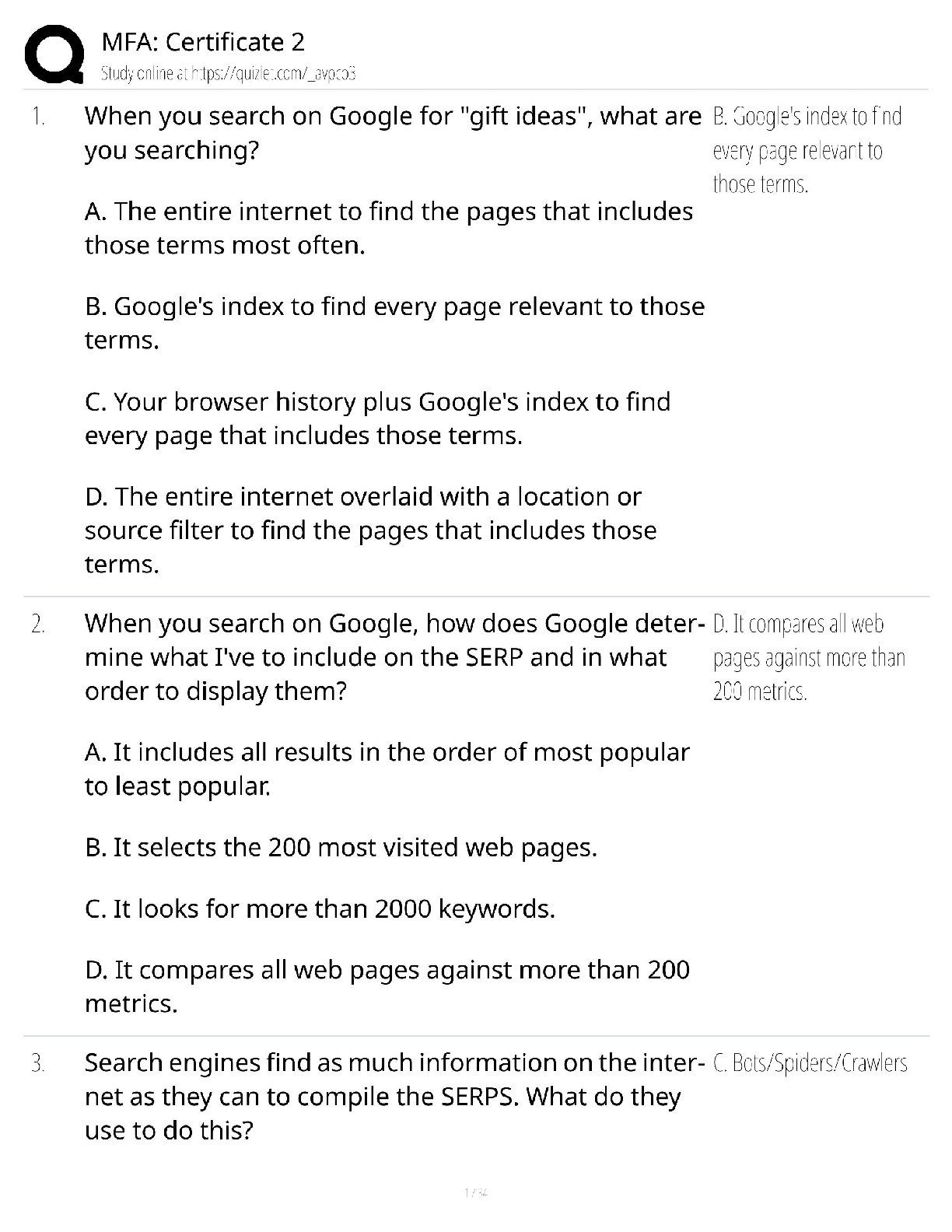Medical Studies > QUESTIONS & ANSWERS > Sample/practice exam 2017, questions and answers Medicine Year 1 (University of Manchester) Questio (All)
Sample/practice exam 2017, questions and answers Medicine Year 1 (University of Manchester) Questions and Correct Answer Keys. With Justification for correct answer
Document Content and Description Below
Sample/practice exam 2017, questions and answers Medicine Year 1 (University of Manchester) Questions and Correct Answer Keys MSCAA Practice Paper 1 2020 Which is the cause of her sudden los ... s of vision? A. Branch retinal artery occlusion B. Branch retinal vein occlusion C. Central retinal artery occlusion D. Central retinal vein occlusion E. Cilioretinal vein occlusion Which is the most appropriate treatment? A. Amitriptyline B. Haloperidol C. Immediate release carbidopa-levodopa D. Lorazepam E. Risperidone Which is the most likely diagnosis? A. Lumbar disc prolapse B. Mechanical back pain C. Osteomalacia D. Osteoporotic vertebral collapse E. Spinal cord compression 4. A 28 year old man is investigated for polyuria and polydipsia. He has bipolar disorder for which he has taken lithium for 2 years. Initial investigations: Sodium 145 mmol/L (135–146) Potassium 3.9 mmol/L (3.5–5.3) Serum osmolality 296 mOsmol/kg (285–295) Urinary osmolality 356 mOsmol/kg (350–1000) Fasting glucose 5.8 mmol/L (3.0–6.0) Serum lithium 0.75 mmol/L (0.5–1.2) Which is the most useful diagnostic investigation? A. 24-h urinary cortisol test B. Glucose tolerance test C. Serum corrected calcium D. Short Synacthen test E. Water deprivation test Which is the most appropriate long-term plan for secondary stroke prevention? A. Apixaban B. Aspirin C. Aspirin and dipyridamole D. Clopidogrel E. Ticagrelor 6. A 49 year old man has 3 days of cough and fever. He undergoes haemodialysis three times per week. His temperature is 38.6°C, pulse rate 90 bpm, BP 122/80 mmHg, respiratory rate 30 breaths per minute and oxygen saturation 95% breathing 15 L/min oxygen via a non-rebreather mask. His JVP is 4 cm above the sternal angle. He has inspiratory crackles in the right mid and lower zone and left upper zone. His blood capillary glucose is 12 mmol/L. Investigations: Sodium 131 mmol/L (135–146) Potassium 5.7 mmol/L (3.5–5.3) Urea 16.7 mmol/L (2.5–7.8) Creatinine 327 μmol/L (60–120) Chext X-ray: see image Which is the most appropriate initial treatment? A. Haemodialysis B. Intravenous 10 mL 10% calcium gluconate C. Intravenous 1000 mL 0.9% sodium chloride over 1 h D. Intravenous co-amoxiclav and clarithromycin E. Intravenous furosemide Which is the most appropriate treatment to give before the scan? A. Intravenous 0.9% sodium chloride infusion B. Intravenous acetylcysteine C. Intravenous furosemide infusion D. Intravenous hydrocortisone E. Intravenous mannitol Which is the most likely cause for her acute kidney injury? A. Glomerulonephritis B. Hypovolaemia C. Renal arterial emboli D. Rhabdomyolysis E. Ureteric obstruction 9. A 76 year old woman has become increasingly confused over the past 2 weeks. She has a history of hypertension and cardiac failure. She is taking bendroflumethiazide, doxazosin, amlodipine, ramipril and atenolol. Her BP is 108/71 mmHg. Investigations: Sodium 121 mmol/L (135–146) Potassium 3.5 mmol/L (3.5–5.3) Urea 10.0 mmol/L (2.5–7.8) Creatinine 105 µmol/L (60–120) Which medication is most likely to be responsible for her presentation? A. Amlodipine B. Atenolol C. Bendroflumethiazide D. Doxazosin E. Ramipril Which is the most appropriate next investigation? A. Cervical spine X-ray B. CT angiography C. CT scan of chest D. CT scan of neck E. MR scan of brain Which is the most likely diagnosis? A. Paroxysmal atrial fibrillation B. Sinus arrhythmia C. Sinus tachycardia D. Supraventricular premature beats E. Supraventricular tachycardia Which is the most likely causative organism? A. Corynebacterium species B. Enterococcus species C. Pseudomonas aeruginosa D. Staphylococcus aureus E. Streptococcus pyogenes Albumin ALT 36 g/L 65 IU/L (35–50) (10–50) ALP 580 IU/L (25–115) Bilirubin 18 µmol/L (<17) γGT 230 IU/L (9–40) Which is the most appropriate next diagnostic investigation? A. CT scan of abdomen B. Endoscopic retrograde cholangiopancreatography C. Liver biopsy D. MR cholangiopancreatography E. Percutaneous transhepatic cholangiography Which is the most likely diagnosis? A. Adenoma B. Carcinoma C. Hamartoma D. Sarcoidosis E. Tuberculosis Which is the most appropriate next management option? A. Continuous positive airway pressure B. Invasive ventilation C. Nasal high flow oxygen D. Nasopharyngeal airway E. Non-invasive ventilation Which is the most likely explanation for the ECG findings? A. Aortic dissection B. Hyperkalaemia C. Myocardial infarction D. Pericarditis E. Pulmonary embolism Which is the most likely diagnosis? A. Myocardial infarction B. Pancreatitis C. Pneumonia D. Pulmonary embolus E. Subphrenic abscess Which further investigation will help to establish the diagnosis? A. Chest X-ray B. ECG C. Nasal swabs D. Transoesophageal echocardiogram E. Urine dipstick analysis Which is the most appropriate immediate management plan? A. Admit and observe for 24 h B. CT scan of head C. Discharge with head injury instructions D. Refer to neurosurgeon E. X-ray of skull Which is the most appropriate initial management plan? A. Botulinum toxin type A injection into bladder wall B. Oral duloxetine C. Oral oxybutynin D. Percutaneous sacral nerve stimulation E. Topical oestrogen Investigations: Haemoglobin 110 g/L (115–165) Creatinine 70 µmol/L (60–120) Calcium 2.90 mmol/L (2.2–2.6) Phosphate 0.65 mmol/L (0.8–1.5) 24 h urinary calcium 7 mmol (2–6) Which is the most likely diagnosis? A. Familial hypocalciuric hypercalcaemia B. Multiple myeloma C. Primary hyperparathyroidism D. Tertiary hyperparathyroidism E. Vitamin D intoxication Which is the most appropriate treatment? A. Apixaban B. Aspirin C. Diltiazem hydrochloride D. No treatment E. Warfarin sodium Which is the most appropriate initial management option? A. Anterior pack B. Antihypertensive medication C. Cautery D. Cryotherapy E. Ice pack Which is the most appropriate initial management? A. Give intravenous piperacillin with tazobactam B. Give Microlax ® enema C. Insert a nasogastric tube D. Start regular intravenous morphine E. Take to theatre for laparotomy Which is the most likely diagnosis? A. Genital herpes B. Gonorrhoea C. HIV seroconversion D. Lymphogranuloma venereum E. Secondary syphilis Which is the most likely cause of his acute deterioration? A. Acute myocardial infarction B. Diaphragmatic hernia C. Lobar pneumonia D. Pneumothorax E. Pulmonary embolus From which artery is the bleeding most likely to be arising? A. Gastroduodenal artery B. Left gastric artery C. Short gastric artery D. Splenic artery E. Superior mesenteric artery Which is the most likely diagnosis? A. Androgen secreting tumour B. Cushing's syndrome C. Polycystic ovary syndrome D. Premature ovarian failure E. Prolactinoma Which antibody test is most likely to diagnose the underlying cause? A. Anti-gastric parietal cell B. Antimitochondrial C. Antinuclear D. Anti-smooth muscle E. Anti-tissue transglutaminase Which treatment is most appropriate to preserve neurological function? A. Chemotherapy B. External beam radiotherapy C. Intravenous bisphosphonates D. Radiation brachytherapy E. Surgical decompression of the spinal cord Which is the most likely diagnosis? A. Essential hypertension B. Glucocorticoid excess C. Phaeochromocytoma D. Primary hyperaldosteronism E. Primary hypoadrenalism Which is the most likely cause of his haematuria? A. Alport's nephropathy B. Drug reaction C. Granulomatosis with polyangiitis D. IgA nephropathy E. Postinfectious glomerulonephritis Which is the most likely diagnosis? A. Cholecystitis B. Chronic pancreatitis C. Duodenal ulcer D. Gastric ulcer E. Gastric carcinoma Which clinical feature is most specific for inflammatory back pain? A. Improvement with activity B. Nocturnal pain C. Radiation to leg D. Stiffness during the day E. Young age Page 36 of 51 Which is the best initial treatment for his acute knee pain and swelling? A. Arthroscopic joint washout B. Intravenous flucloxacillin C. Oral allopurinol D. Oral naproxen E. Oral prednisolone Page 37 of 51 Which is the most appropriate additional intravenous treatment? A. 500 mL 0.9% sodium chloride over 15 min B. 500 mL Hartmann's solution over 15 min C. Dopamine hydrochloride D. Furosemide E. Noradrenaline/norepinephrine Page 38 of 51 Which is the most appropriate next step in management? A. MR scan of shoulder B. Refer for orthopaedic opinion C. Refer for physiotherapy D. Ultrasound scan of shoulder E. X-ray of shoulder Page 39 of 51 Which is the most suitable initial treatment? A. Diamorphine hydrochloride B. Glycopyrronium C. Hyoscine hydrobromide D. Midazolam E. Mirtazapine Page 40 of 51 In which part of the brain are changes most likely to be found in early Alzheimer’s disease? A. Basal ganglia B. Frontal lobe C. Medulla oblongata D. Parietal lobe E. Temporal lobe Page 41 of 51 Which is the most appropriate immediate management option? A. Activated charcoal B. Intravenous amiodarone hydrochloride C. Intravenous atropine sulfate D. Intravenous magnesium E. Intravenous sodium bicarbonate Page 42 of 51 Which is the most appropriate method for providing analgesia during the early postoperative period? A. Epidural anaesthesia B. Intramuscular opioid C. Oral non-steroidal analgesia D. Patient controlled intravenous analgesia E. Spinal anaesthesia Page 43 of 51 Which type of study design is being used? A. Case–control study B. Case series C. Cohort study D. Cross-sectional study E. Ecological study Page 44 of 51 Which type of antihypertensive is most appropriate? A. ACE inhibitor B. Alpha blocker C. Beta blocker D. Calcium channel blocker E. Thiazide-like diuretic Page 45 of 51 Which investigation is most likely to confirm the diagnosis? A. Blood cultures B. Bronchoscopy C. Echocardiography D. High resolution CT scan of chest E. Induced sputum for microscopy and culture Page 46 of 51 Which is the most likely diagnosis? A. Delirium tremens B. Fluoxetine overdose C. Hepatic encephalopathy D. Korsakoff's psychosis E. Wernicke's encephalopathy Page 47 of 51 Which mechanism best explains the development of hyponatraemia? A. Increased sodium secretion in the distal tubule B. Increased water absorption in the collecting duct C. Increased water ingestion D. Reduced cortisol secretion E. Reduced sodium reabsorption in the proximal tubule Page 48 of 51 Which is the most appropriate next step in management? A. Erythrocyte sedimentation rate B. Lumbar puncture C. MR scan of brain D. Refer to outpatient headache clinic E. Start amlodipine Page 49 of 51 Which is the most appropriate therapeutic change? A. Start co-codamol B. Start ibuprofen C. Start prednisolone D. Stop bisoprolol E. Stop simvastatin Page 50 of 51 Which additional investigation is most likely to confirm the diagnosis? A. Creatine kinase B. Erythrocyte sedimentation rate C. Serum 25-OH cholecalciferol D. Ultrasound scan of neck E. X-ray of thoracic and lumbar spine [Show More]
Last updated: 3 years ago
Preview 1 out of 83 pages
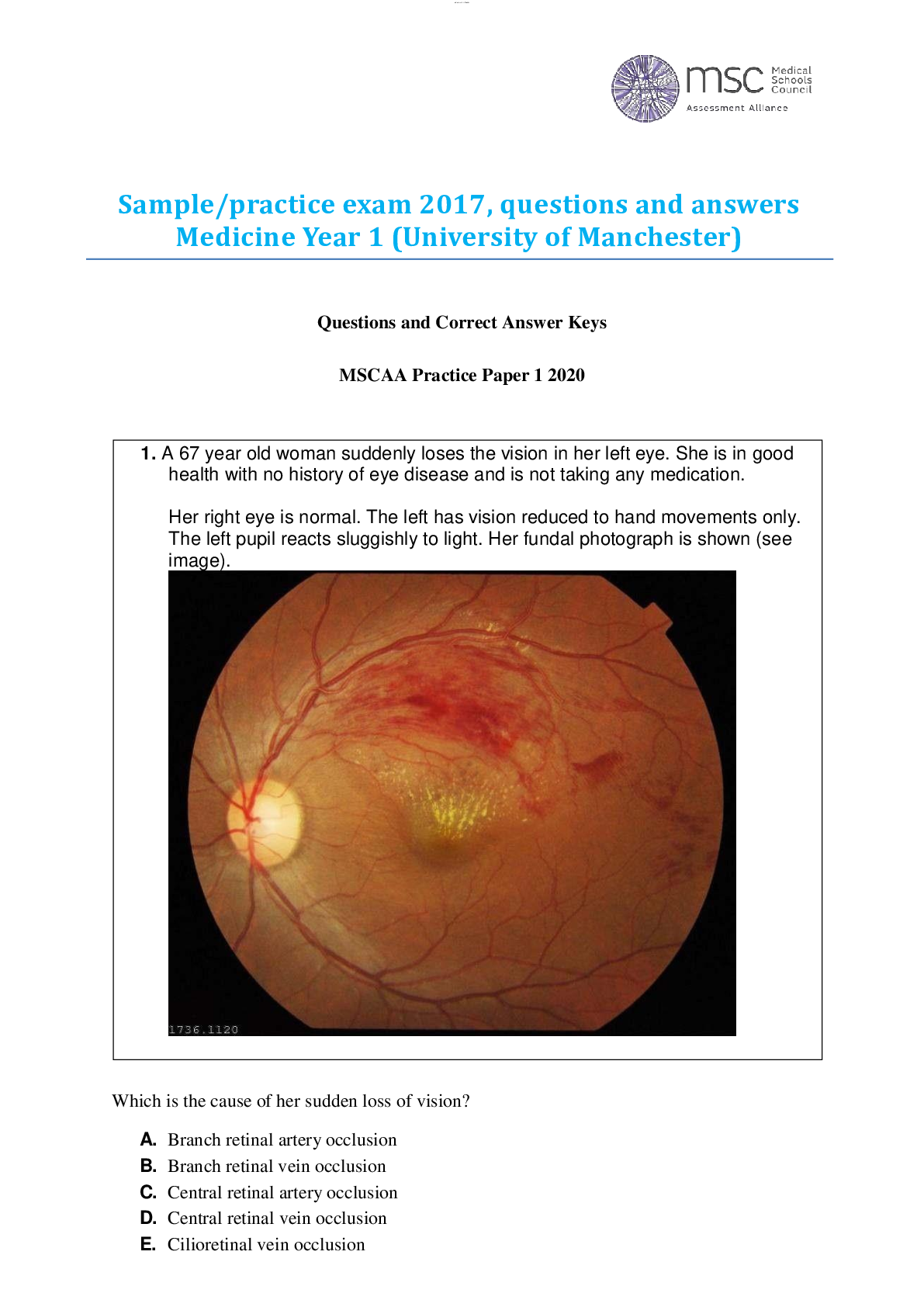
Buy this document to get the full access instantly
Instant Download Access after purchase
Buy NowInstant download
We Accept:

Reviews( 0 )
$15.00
Can't find what you want? Try our AI powered Search
Document information
Connected school, study & course
About the document
Uploaded On
Apr 27, 2020
Number of pages
83
Written in
All
Additional information
This document has been written for:
Uploaded
Apr 27, 2020
Downloads
0
Views
537






.png)
.png)
.png)
.png)
.png)
.png)
.png)

